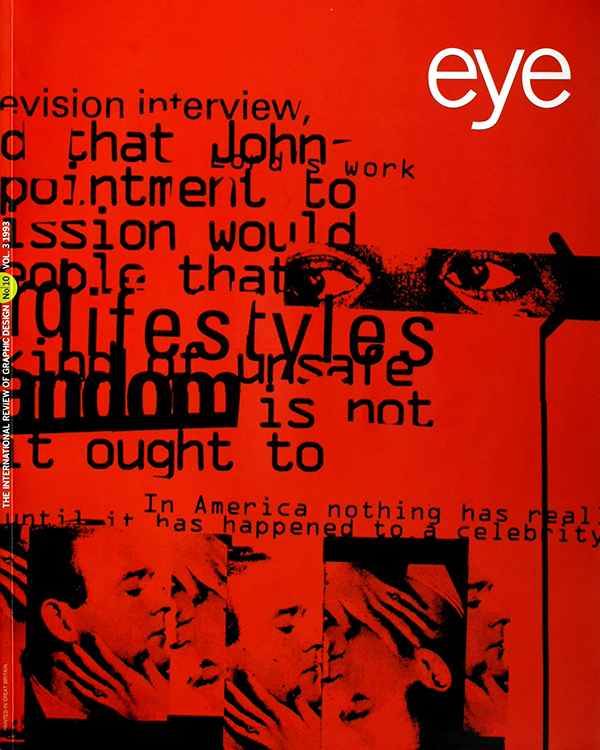Autumn 1993
Whose content is it?
Letter from Miles Newlyn in Eye 10
In ‘Whatever became of the content?’ Rick Poynor seems to promote a particular design solution as an international style. There seems no place for different methods to co-exist, but rather that this ‘new design’ should supersede the last one.
The concept of appropriateness is ignored (besides saying that this approach ‘can work just as well in mainstream publications’), and Poynor does not mention how or if the approach has any relevance to added value or product identification, which are still the main reasons for graphic design. The irony is that he runs the risk of promoting a style to be applied without thought for content.
The essay raises the questions, who is speaking and where does the content come from? Time and time again we are lectured on the primacy and authority of the text or client, but just where does the ‘content’ come from?
Obviously in book and publication design the author is the primary giver of meaning, but in many other fields, clients, be they manufacturers, service suppliers, retailers or whatever, are not the author of the content. They are in business to supply a market with what the market wants (and this is relevant to publications too) and as such are one link in a social and economic system. The designer’s client is often interpreting the results of market research (viewer-content) into products and services available at a price.
I am suspicious of the continuing implication that Modernism was something created by a cultural elite, in isolation from market trends, and that it was ethically motivated. Switzerland at that time was a very democratic country, and so a graphic style that represented the concomitant ideals of stability, continuity and equality would be marketable. It was obvious that ‘functionality’ would be accepted by consumers, since through the democratic process they had imposed legal constraints that reduced advertising to essentially a medium of information. Swiss Style was a response to the needs and preferences of the market, which is not to say that it lacked beauty or creativity.
Steven Heller condescendingly notes that Jeffery Keedy and Allen Hori ‘had a modicum of design experience before attending Cranbrook, [and] availed themselves of the luxury of experimenting free of marketplace demands.’ I don’t believe the interference that these places of experiment, and this applies to the European Modernists too, are entirely isolated from society, cultural vacuums free from marketplace contamination. In fact, I believe quite the reverse: I see these graduate design programmes being used to immerse oneself in personal human experience, and that is the battleground of the market economy. The experience of living in the modern environment is shared, and often the ideas produced are a result of form being given to the many emotions and concepts floating around in the public consciousness.
I don’t intend to portray post-Cranbrook work as ‘new design’, as Poynor does, but to point out that like Modernism it has proved to be marketable, people want it, it works. The state of the current economic system and market is far removed from that which called for an unobtrusive medium for the clear communication of ‘content’ in postwar Switzerland. I do not deny that there are people for whom this would be a welcome clearing of the air in this age of ‘in your face’ puerile marketing propaganda, but I think it is irresponsible to portray graphic solutions as right or wrong without first discussing the nature of the content and the viewer for whom it is intended.
If Poynor meant to say that this kind of design solution might maximise audience acceptance by identifying an increasing need for clarity, thereby moving more product, then the usefulness of that depends upon its applicability to the kind of ‘content’ we are asked to communicate.
Leicester, UK
First published in Eye no. 10 vol. 3 1993
Eye is the world’s most beautiful and collectable graphic design journal, published for professional designers, students and anyone interested in critical, informed writing about graphic design and visual culture. It is available from all good design bookshops and online at the Eye shop, where you can buy subscriptions and single issues.

